Spruce Budworm
Spruce forests in western Foothills County are currently experiencing an outbreak of Spruce Budworm (Choristoneura fumiferana, aka Eastern Spruce Budworm). Spruce budworm are native pests that feed on spruce and fir tree species. Spruce budworms are always present in our forests; however, they can reach epidemic levels and cause significant damage. These outbreaks occur in cycles every 20 to 40 years and are natures way of recycling nutrients and opening the forest canopy to new growth in overmature spruce and fir forests. Budworm numbers can increase to epidemic levels due to favourable environmental conditions such as consecutive warm, dry springs and summers as well as an increase in the number and age of spruce trees and reduction in their natural enemies. Outbreaks can last many years and are ended by food depletion, increase in natural enemies and diseases, or environmental conditions such as a late frost. Unlike other forest pests, such as the Mountain Pine Beetle, Spruce Budworms are not significantly affected by very low temperatures during the winter months.
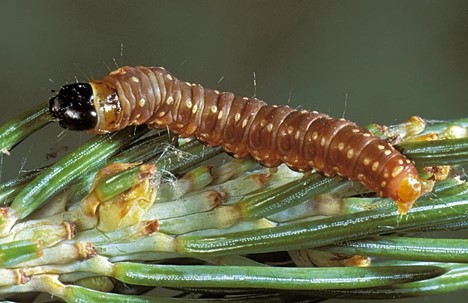
Spruce budworm (Choristoneura fumiferana) larvae.
Photo courtesy of Natural Resources Canada Spruce budworm (nrcan.gc.ca)
Life cycle
Spruce budworm is a member of the insect Order lepidoptera (moths and butterflies) and as such follows a typical moth lifecycle from egg to caterpillar to pupae to adult. Eggs are laid in small groups in late July and August. The early instars are very small and do not cause significant damage. These small larvae overwinter and emerge in May. Budworms in the 4th to 6th instar caterpillar phases are responsible for the majority of feeding and damage. In July, the larvae begin to pupate (change to moths) and will emerge as adults in late July or early August and begin laying eggs.
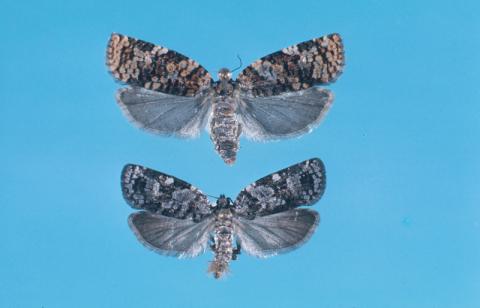
Spruce budworm adult.
Photo courtesy Natural Resources Canada Spruce budworm (nrcan.gc.ca)
Damage
Spruce budworms feed on mainly new growth, damaging the crown and ends of branches. They will also feed on spruce flowers and cones. Healthy spruce trees are able to withstand multiple years of defoliation from feeding. Tree growth will be slowed by the second year and trees can begin to die after 5 to 7 years of severe defoliation.
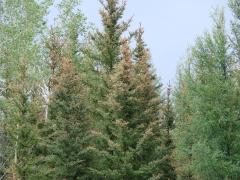
Severe defoliation, larvae are feeding on the entire crown and lower branches. Photo courtesy Alberta Agriculture, Forestry and Rural Development
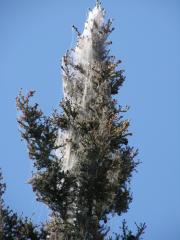
Copious webbing indicates high larval numbers.
Photo courtesy Alberta Agriculture, Forestry and Rural Development
Control
Widespread control of Spruce budworm is extremely difficult and expensive. Large scale spraying campaigns in eastern Canada have required multiple years of treatment across tens of thousands of hectares to stop outbreaks. Treatment programs may also prolong the infestation by reducing the number of natural enemies and preserving foliage for future budworm generations. One of the main factors in the collapse of budworm populations is the lack of food as larvae run out of sufficient forage to complete their life cycle. The reduction in numbers of budworm larvae will also cause a reduction in predators as the birds and insects that feed on larvae will move on to new food sources. Foothills County recommends focusing control strategies on a small number of trees that hold significant aesthetic or sentimental value. Any control done, at a landowner or even municipal level, will not reduce the duration of the outbreak but can protect foliage and save trees if the outbreak reaches a level that threatens tree survival.
Frequently asked questions
Are my trees at risk of dying?
Currently the outbreak has not been ongoing long enough to cause significant mortality in healthy spruce trees. Overmature trees are the most at risk of dying, followed by young saplings.

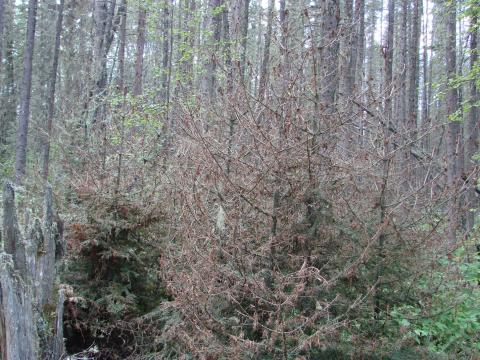
Multiple years of severe defoliation will eventually cause tree mortality.
Photos courtesy Alberta Agriculture, Forestry and Rural Development
If I do want to spray, what chemical should I use?
Btk (Bacillus Thuringiensis Kurstaki) is a biological insecticide that is registered for the control of Spruce budworm on shade trees. The naturally occurring bacterium produce toxins that are only harmful to insects in the order lepidoptera (moths and butterflies). While this option could be used, we do not advise the widespread use of Btk as it will also kill native moths and butterflies. Other domestic use products, such as pyrethrin’s and insecticidal soaps, should not be used because they pose a serious risk to the environment and may damage the trees being treated. We strongly discourage the use of any broad-spectrum synthetic insecticides due to the high risk they pose to human and ecological health.
If you do proceed with treatment, the application should be timed during the 4th instar phase, when the caterpillars turn brown and are visibly feeding. Larval growth will be dependent on environmental conditions, but budworm larvae will typically reach this stage in mid to late June. Any spraying done after this dater will be ineffective as the larvae need to be actively feeding to ingest the pesticide.
Always read and follow the pesticide label directions.
Please note: Any pesticide applications must be contained to your property only. Any applications or drifting of sprays onto neighbouring properties without written consent is a violation of the pesticide label, provincial, federal and civil laws. Before applying any pesticide, you should be aware and follow all guidelines and set back distances listed on the label or within Alberta regulations. Although some pest control products pose little danger to humans and mammals, they can have severe impacts on aquatic ecosystems and native insect populations.
All contractors applying any pesticide product must hold a valid Alberta Pesticide Service Registration. Please ensure any contractor applying pesticides on your property are properly licensed and insured.
If you wish to report pesticide misuse or drift please contact the Alberta Energy & Environmental Response Line 1 800 222-6514 Energy and Environmental Response Line | Alberta.ca.
Where can I purchase Btk products?
Domestic grade Btk products can be found at most home and garden retailers. We recommend pre-ordering if you are planning on doing a large application.
What is Foothills County doing?
Currently we are working with our neighboring municipalities and provincial authorities to monitor the outbreak and provide advice to our residents.
Other than spraying, what can I do?
The best defense to any tree pest or disease is to encourage resilience in your trees and forests. In caring for your managed trees, watering (test water for salts before watering) and mulching can help the trees to recover from defoliation. Spaying water with high pressure hoses can be used to dislodge larvae from trees and reduce their feeding and damage. General forest health practices, such as selective harvest of overmature trees, thinning of the forest canopy and promoting a diversity of species, will help your forests cope not just with Spruce budworm but the many other pests and diseases that have evolved with our forests.
Update December 22, 2022:
Government of Alberta staff completed an aerial survey of the area and found the outbreak has largely collapsed in Foothills County and surrounding areas. There may still be isolated area’s that are experiencing defoliation and landowners concerned about their tree’s should follow the best management practices found below. See map here.
For more information, please contact Foothills County Agricultural Services 403-652-2423
Resources
Spruce budworm in Alberta - Spruce Budworm in Alberta
Natural Resources Canada fact sheet - Spruce budworm (factsheet) (nrcan.gc.ca)
Rocky View County Spruce budworm information page - Rocky View County Spruce Budworm | Rocky View County
